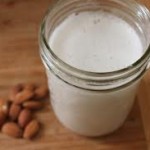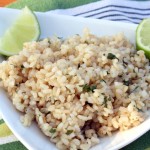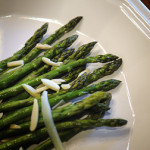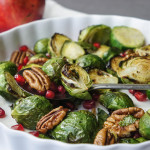Recipes
Ingredients
- 1 Cup Raw almonds Preferably organic
- 2 Cups Water (Plus more for soaking)
- 1 Single Date or prunes For sweetening
Servings:
Instructions
- Soak the almonds overnight or up to 2 days. Place the almonds in a bowl and cover with about an inch of water. They will plump as they absorb water. Let stand on the counter, covered with a cloth, overnight, or refrigerate for up to 2 days. The longer the almonds soak, the creamier the almond milk.
- Drain and rinse the almonds. Drain the almonds from their soaking water and rinse them thoroughly under cool running water. At this point, the almonds should feel a little squishy if you pinch them. (It's best to discard the soaking water because it contains phytic acid, which inhibits the body's ability to absorb nutrients.)
- Combine the almonds and water in a blender. Place the almonds in the blender and cover with 2 cups of water.
- Blend at the highest speed for 2 minutes. Pulse the blender a few times to break up the almonds, then blend continuously for two minutes. The almonds should be broken down into a very fine meal and the water should be white and opaque. (If using a food processor, process for 4 minutes total, pausing to scrape down the sides halfway through.)
- Strain the almonds. Line the strainer with either the opened nut bag or cheese cloth, and place over a measuring cup. Pour the almond mixture into the strainer.
- Press all the almond milk from the almond meal. Gather the nut bag or cheese cloth around the almond meal and twist close. Squeeze and press with clean hands to extract as much almond milk as possible. You should get about 2 cups. (See Recipe Note for what to do with the leftover almond meal.)
- Sweeten to taste. Taste the almond milk, and if a sweeter drink is desired, add sweetener to taste.
- Refrigerate almond milk. Store the almond milk in sealed containers in the fridge for up to two days.
Share this Recipe
|
|
Powered byWP Ultimate Recipe
Ingredients
- 1.5 Cups Short grain wild rice
- 1.5 Cups Peas (Thawed if frozen)
- 1 Bunch Fresh cilantro (Large bunch)
- 1 to 2 Raw corns (or 1.5 cups frozen sweet corn thawed if frozen)
- 5 Cloves garlic Finely diced, take germ out)
- 1 Medium size Red bell pepper (diced)
- 1 Tsp Coconut oil
- 1 Tsp olive oil Extra virgin first cold press
- 1.75 Cups Red onion Finely diced
- 3 Cups Water
- 1.5 Tbs Aji Amarillo Peruvian yellow chili
- Sea Salt
- Ground Pepper
Servings:
Instructions
- After rinsing the cilantro with filtered water, pull all the stems off the cilantro, and place all the leaves in a blender. Add 1/4 cup of water and blend on high speed for 50 seconds until cilantro turns into a paste (or more like a green liquid. Either way is fine). Set aside the cilantro blend. In a medium pot, add the coconut oil and place it in the stove on high heat. Add the onion, garlic, a pinch of black pepper and sea salt. Saute for about two minutes or until onions are translucent. Bring the heat down to medium high, add the cilantro paste and aji amarillo, and mix. Then add the brown rice and saute for about two more minutes. Add the corn, peas, red bell pepper and olive oil 1/2 tablespoon of sea salt, and blend well. Add three cups of water and mix with all ingredients. Turn heat back to high and cover. As soon as the water starts boiling, turn the heat down to medium low and set your timer for 1 hour and 15 minutes. Once the timer goes off, check the rice. If there is still some water left but the rice is cooked, mix well, turn the heat to medium high, and let it cook for about 10 more minutes. Check it again and taste. Add more sea salt if needed. Even if there is still some water but the rice is cooked, turn the heat off and blend together. I serve it a little “wet”, but the water will eventually dry out as it sits in the pot while cooling off.
Share this Recipe
Powered byWP Ultimate Recipe
Ingredients
- 1 Pound Asparagus about 20 spears
- 1 Tbsp Coconut oil Organic is best
- 2 Tsp Thyme Dried
- .25 Tsp Sea Salt To taste
- .25 Tsp Black pepper To taste
- 3-4 Tbsp Slivered almonds May toast in advance
Servings:
Instructions
- Preheat oven to 400 F. Wash and remove the tough ends of the asparagus. Place in a roasting pan or on a baking sheet. Drizzle the oil/fat and thyme over the asparagus and toss together until well coated. Add almonds. Bake for 10 minutes, then reduce the heat to 250 F for 15 more minutes. Season with sea salt and freshly ground black pepper to taste.
Share this Recipe
Powered byWP Ultimate Recipe
Ingredients
- 6 Cups Brussels sprouts About 1.5lbs, halved (keep and use the leaves that fall off when cutting)
- 2/3 Cups Brazilian nuts, raw Chopped (other nuts may also be used such as almonds, macadamia nuts, pecans, walnuts, etc.)
- 1 Cup Pomegranite seeds
- 2 Tbs olive oil Cold pressed and unrefined
- 1 Tsp Garlic powder
- 1 Tsp Black pepper Freshly ground
- 1 Tsp Salt
Servings:
Instructions
- Preheat oven to 350 F. In a small bowl, whisk together olive oil, garlic powder, pepper, and salt. In a medium bowl, toss together the brussels sprouts and nuts with the olive oil mixture. Place the mixture onto a baking sheet, and bake for approximately 20-30 minutes, tossing occasionally throughout the cooking process. When brussels and nuts have reached desired crispiness, remove from oven and place into serving bowl. Toss with pomegranates and serve immediately.
Share this Recipe
Powered byWP Ultimate Recipe
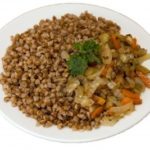
|
Always do your best to choose organic buckwheat or kasha. Organic buckwheat tend to contain more nutrients and fewer pesticides. Most natural foods stores carry buckwheat. Be sure to check their bulk section first.
Buckwheat is high in rutin, a flavonoid that protects against disease by strengthening capillaries and preventing blood clotting. Coupled with its high levels of magnesium (one cup cooked provides over 20 percent of the Daily Value), which lowers blood pressure, buckwheat is truly a heart-healthy food. Buckwheat is completely gluten-free and suitable for those with celiac disease. Although you can store buckwheat in a cool, dry place for a short amount of time, it is best to keep it in the refrigerator, where it will last up to three months, or in the freezer, for six months.
|
Instructions
- To toast: place groats in dry pan over medium heat, stirring for five minutes, until browned. Whether you're preparing kasha or untoasted buckwheat groats, place in a pot with water, add some salt and bring to a boil. Reduce heat to low, and simmer until tender. Kasha requires significantly less cooking time than untoasted buckwheat; adjust accordingly. You may roast or prepare grilled/sautéed vegetables in advance and serve them with Buckwheat (kasha). Makes great side dish.
Share this Recipe
Powered byWP Ultimate Recipe
Yuliya Klopouh, Pharm.D.
The Orpheus Clinic
Baltimore, MD
Phone: (443) 854-8673

